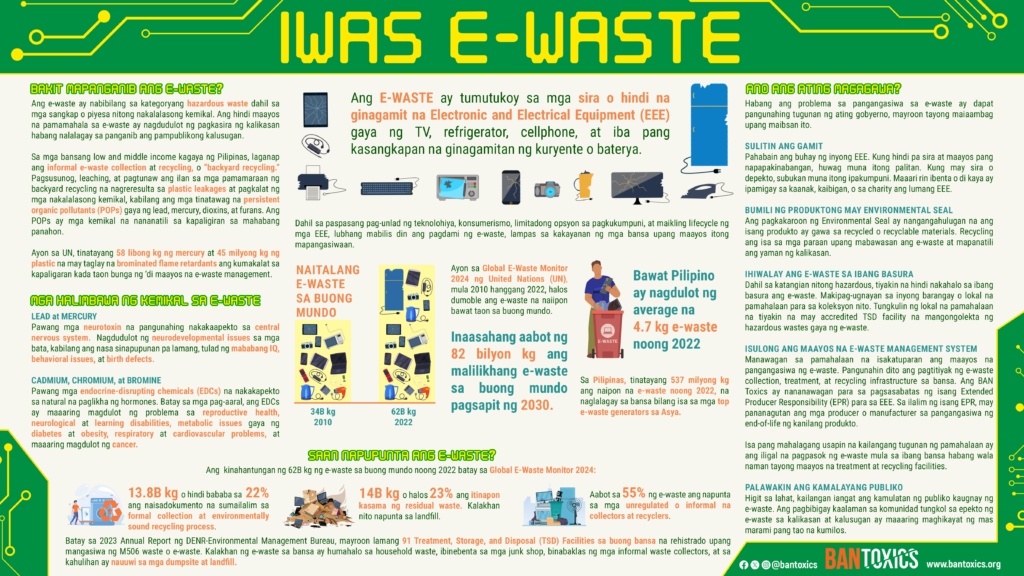
October 14, 2024 – In observance of International E-Waste Day, toxic watchdog BAN Toxics has released a new infographic to raise awareness among Filipinos about the growing issue of Waste from Electrical and Electronic Equipment (WEEE), or e-waste. Titled “IWAS E-WASTE (AVOID E-WASTE),” the Tagalog resource explains what e-waste is, the dangers it poses to human health and the environment, the challenges in managing it, and offers practical tips on how to reduce it.
“E-waste is a growing global concern and one that is being poorly addressed right now, even in the country. With this IEC (information, education, and communication) material, we hope to inform our fellow Filipinos about the urgent need to take action against this threat to public health and the environment,” said Thony Dizon, BAN Toxics Campaign and Advocacy Officer.
WEEE is defined under the Basel Convention on the Control of Transboundary Movements of Hazardous Wastes and their Disposal as “electrical or electronic equipment that is waste, including all components, sub-assemblies, and consumables that are part of the equipment at the time it becomes waste.” Common sources of e-waste in the Philippines include consumer products such as televisions, refrigerators, washing machines, and mobile phones.
According to Dizon, the lack of a proper e-waste management system and limited public awareness are key challenges in the Philippines. He added that based on the January 31, 2023, list of the Department of Environment and Natural Resources – Environmental Management Bureau (DENR-EMB), there are only 91 Treatment, Storage, and Disposal (TSD) Facilities across the country registered to handle M506 waste, or e-waste. This, he said, “reflects the lack of access to proper e-waste disposal facilities and infrastructure, especially in rural areas.”
“The majority of e-waste in the country ends up mixed with common household waste or is collected by the informal waste sector and sold to junk shops, where it is improperly dismantled. Ultimately, it ends up in dumpsites and landfills. Due to the toxic materials in e-waste, these practices expose the public to significant health and environmental hazards.”
A 2023 study by BAN Toxics on informal e-waste recycling revealed that in Quezon City alone, 30% of e-waste is recycled informally in junk shops. Quezon City has the highest population of any city or town in the country.
Meanwhile, data from the United Nations’ (UN) Global E-Waste Monitor 2024, released earlier this year, estimated that 537 million kg of e-waste were generated in the Philippines in 2022, making the country one of the top e-waste generators in Asia. The report also disclosed that only 13.8 billion kg, or 22%, of the total 62 billion kg of global e-waste underwent environmentally sound recycling processes. About 14 billion kg, or 23%, were mixed with residual waste that ended up in landfills, while the remaining more than half went to unregulated or informal collectors and recyclers.
E-waste contains highly toxic chemicals such as lead, mercury, cadmium, chromium, and brominated flame retardants, among others. Mismanagement of e-waste results in the release of these chemicals into the environment. The UN report estimates that 58,000 kg of mercury and 45 million kg of plastic containing brominated flame retardants are released into the environment annually.
Dizon stated that the infographic emphasizes the importance of public awareness in addressing the issue of e-waste. “Proper waste segregation and the practice of reuse principles are simple actions each of us can take. Beyond this, we need to urge our government at all levels to take decisive action in establishing an environmentally sound e-waste management system.”
Currently, there is no specific Philippine law governing e-waste, although there are technical guidelines for its management under Republic Act (RA) 9003, or the “Ecological Solid Waste Management Act of 2000,” and RA 6969, also known as the “Toxic Substances and Hazardous and Nuclear Wastes Control Act of 1990.”
BAN Toxics advocates for stronger regulatory measures on e-waste in the country, including the enactment of an Extended Producer Responsibility (EPR) law for electronics. An EPR law would hold manufacturers accountable for their products at the end-of-life cycle, facilitating environmentally sound management and shifting the burden of e-waste management from taxpayers to producers, in line with the polluter-pays principle and cost internalization.
The environmental justice group also calls on the government to immediately ratify the Basel Ban Amendment, which prohibits member states of the Organization for Economic Cooperation and Development (OECD), the European Union (EU), and Liechtenstein from exporting hazardous wastes to developing countries, whether for recycling or not.
According to Dizon, another pressing issue is the transboundary flow of e-waste from developed countries to nations like the Philippines, which lack proper recycling infrastructure. “We are no strangers to the dumping of hazardous waste from developed countries,” Dizon added, citing cases of illegally imported waste from Canada, South Korea, Hong Kong, and Australia over the past decade.
“On International E-Waste Day, let’s commit to more sustainable production and consumption of electronic and electrical goods, focusing on reducing waste, preserving value within the system, extending product lifespans, and increasing their potential for repair, recycling, and reuse.”
First introduced in 2018 by the WEEE Forum to raise awareness of the need for e-waste recycling among consumers, International E-Waste Day takes place every year on October 14.
References:
https://ewastemonitor.info/the-global-e-waste-monitor-2024/
https://emb.gov.ph/wp-content/uploads/2023/02/TSD-as-of-January-31-2023.pdf
https://drive.google.com/file/d/1t6jcOS-_jpG4lnSKFa3QUfwiL8lkQcVS/view?fbclid=IwAR0ZrLLPh0n0mNAFIy3RqEyu-PK5fCHhZYk5LvJ1o-K7H8Q1sFbw1DZ5hKA
